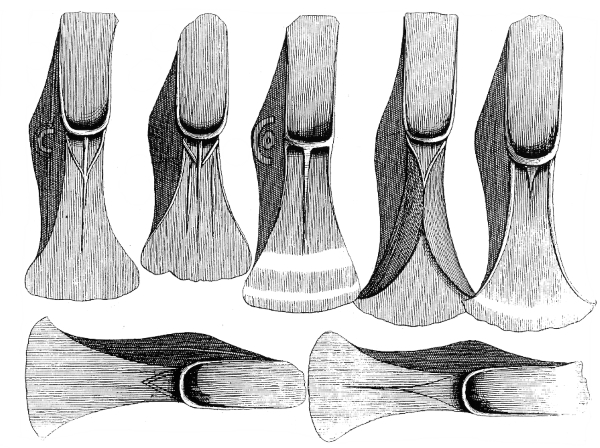
Today’s image shows an illustration of some of the objects in the first Bronze Age Hoard whose discovery was recorded on Thanet. The hoard, consisting of twenty seven palstave axes dating from the Middle Bronze Age, was found in 1724 at Mutrix Farm ( a place name also recorded as Mutterer or Motherwicks) on the cliff top near St Mildred’s Bay, Birchington. A record of this discovery, with the illustration shown above, was published in 1736 by the Reverend John Lewis in his book on the History and Antiquities of the Isle of Thanet:
‘Betwixt this place and the Sea were found AD 1724 by William Castle, who occupied a small Farm here, as he wwas digging a Sea-gate, or a Way thro’ the Cliff into the Sea, to fetch up Oore or Waure for his Land, XXVII such instruments as I have described in the adjoining Plate lying all together about two Feet underground, so that it is a little strange, that they were not before this discovered by the plough. They were of mixt Brass, or what they call bell or Pot-metal, of several Sizes, and somewhat different shapes, but on both Sides alike, as they are here represented. The largest of them were 7 Inches one quarter long, and 2 Inches three quarters broad at the bottom the lesser ones were 5 Inches in Length and 2 Inches and one half in Breadth at the Bottom. Two of them had Ringles on one Side about the middle, which was the thickest or deepest part.’
It has been suggested that the illustration reproduced by Lewis was copied from an original drawing made by the famous Antiquarian William Stukeley while he was travelling through Kent (Ashbee 2001).
References
Ashbee, P. 2001. William Stukeley’s Kentish Studies of Roman and other Remains. Archaeologia Cantiana 121, 61-102.
Lewis, J. 1736. The History and Antiquities of the Isle of Tenet. London. 2nd Edition
Perkins, D. R. J. 2000. A Gateway Island. Thesis submitted for the Degree of Ph.D to the Institute of Archaeology, University College London.
